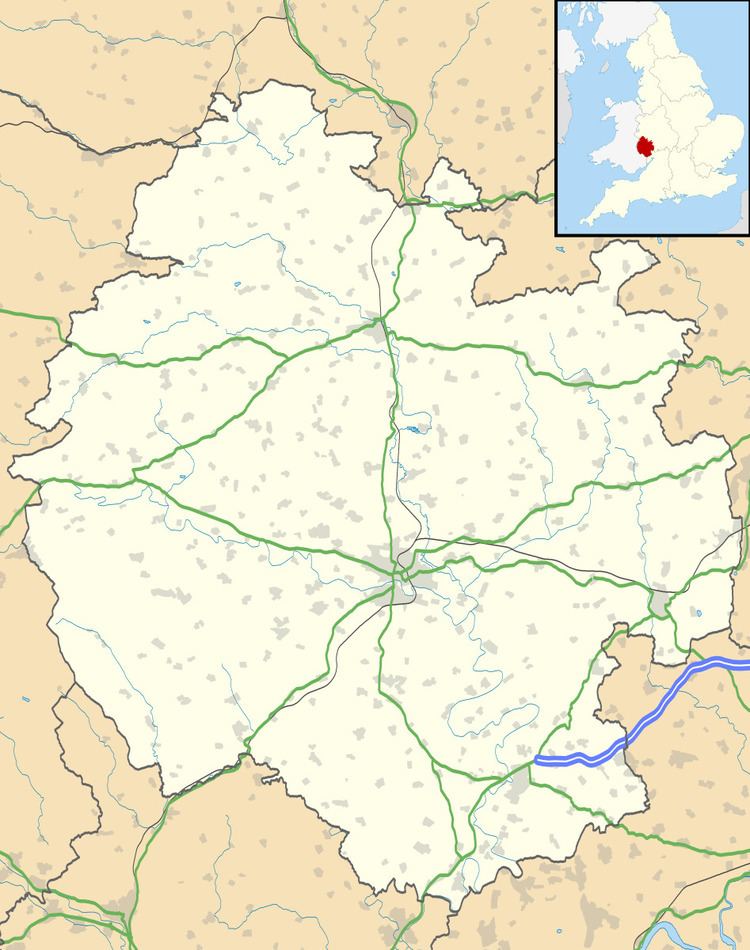OS grid reference SO3355 Local time Wednesday 5:26 PM Population 757 (2011) | Unitary authority Sovereign state United Kingdom Dialling code 01544 | |
 | ||
Weather 14°C, Wind S at 5 km/h, 61% Humidity | ||
Lyonshall ( /ˈlaɪənzhɔːl/) is a historic village and civil parish in Herefordshire, England. According to the 2001 census it had a population of 750 increasing to 757 at the 2011 Census.
Contents
Map of Lyonshall, Kington, UK
Location
Lyonshall is a parish in the northwest corner of the county of Herefordshire, England. It is near to the border with Wales and has significant stretches of Offa's Dyke running through it. The northern boundary of the parish is marked by the River Arrow. Lyonshall Parish covers 5,000 acres (2,000 hectares) and is on the Black and White Village Trail. The population of 750 people live in 280 households spread across the parish and centred in the village. The town of Kington is 3 miles (4.8 km) to the west of Lyonshall.
History
Lyonshall was listed under the name Lenehalle the Domesday Book of 1086. The entry reads:
'LYONSHALL. Walter holds from him . Thorkell held from Earl Harold . 5 hides which pay tax. In Lordship 2 ploughs; 3 villagers, 11 smallholders and 3 riding men with 5 ploughs. 5 slaves, male and female. From some men settled there 110d are given for as long as they wish . Value before 1066, 60s; now 50s.'
Lyonshall is listed as being in the land of Roger of Lacy in Elsdon Hundred. Other villages in the same Hundred were Hopley's Green, Woonton, Eardisley and Letton. Also making an appearance in Domesday Book are the adjacent parishes of Kington, Titley and Rushock, all described as non-tax paying waste lands. To the east of Lyonshall lies Pembridge, which, like Lyonshall, is described as a reasonable sized manor.
Lyonshall Castle is today a picturesque ruin in private ownership, with well-formed moat and outer enclosure covering approximately three acres. The building of the castle started in about 1090, when the Devereux family, sometimes referred to as d'Évreux or D'Ebroicis, held it as lords of the manor from Roger de Lacy. Lyonshall was important as one of the border manors of the Marcher lords. Its position, occupying a useful spot on the roads to and from Wales, attracted military interest, and it is clear that many of the castle occupants continued to lead lives of some national significance, often serving in the Royal Courts. Many of Lyonshall's lords have been eminent figures, both famous and infamous. In 1322, for example, the castle is mentioned as being part of the estates of Bartholomew de Badlesmere, 1st Baron Badlesmere, who was described on his execution as 'a great Baron and as great a Rebel.' It seems that even after Magna Carta, some of the Marcher Lords continued to be troublesome to the king. Bartholomew's only son, Giles, died without issue and so Lyonshall became the property of his sister and co-heir Maud; women were often substantial landowners in the Middle Ages. She married John de Vere, 7th Earl of Oxford and one of the heroes of the Battle of Crecy in 1346.
In 1392, Lyonshall passed to Simon de Burley, a royal favourite. Introduced to court at a young age, he went to sea at the age of 14 to fight the Spanish, and he was a soldier until his capture by the French at Poitou in 1369. He was a court tutor, and his former pupil, Richard II, made him Governor of Windsor and Llanstephan, Master of Falconry and Keeper of the Royal Mews; he also received a great number of manors and estates in reward for his service. However, he was charged with treason by the Duke of Gloucester and although the king and queen personally knelt to beg for his pardon, he was executed on 15 May 1388.
Community
The parish has the church of St Michael & All Angels and the Lyonshall Memorial Hall. The Parish Council is well supported and achieves improvements around the parish and voices opinions of parishioners to the Herefordshire Council. There is no post office in the village and the Royal George pub is closed.
In the 19th century, from about 1870 to sometime in the 1890s, the Vicar of Lyonshall was Charles Madison Green, whose wife, Ella, was the eldest sister of author H. Rider Haggard, famous for King Solomon's Mines and She.
Commerce
Lyonshall parish has a largely agricultural economy. It hosts six substantial poultry farms, produces blackcurrants, potatoes and livestock as well as the normal arable crops.
The major businesses are Burgoynes of Lyonshall – which owns farms, hires marquees and runs a fleet of lorries – and Lynhales Nursing Home which employs almost 100 people in caring for around 50 elderly residents in a historic manor house.
As well as the larger businesses there is a myriad of smaller, often one-person enterprises spread across the parish. The Royal George pub, now closed, is in the centre of the village and is a black and white building dating from 1600. Since it's closure and purchase from it's previous owner, it has fallen into a poor state of repair. It was originally named The George, but was renamed after the naval disaster of 1782 when the flagship The Royal George sank at Spithead with the loss of 900 lives. There is a company, The Four-Poster Bed Coy, producing hand-made beds and other furniture specialising in the use of sustainable local oak. Mayglothlings Waste Ltd is based in the parish and has a fleet of tankers seen around the West Midlands, as well as Mercia Drain Ltd that is in the same line of business.
In popular culture
Sue Gee's 2004 novel The Mysteries of Glass concerns a curate working in the parish of St. Michael and All Angels in Lyonshall in 1860/1.
